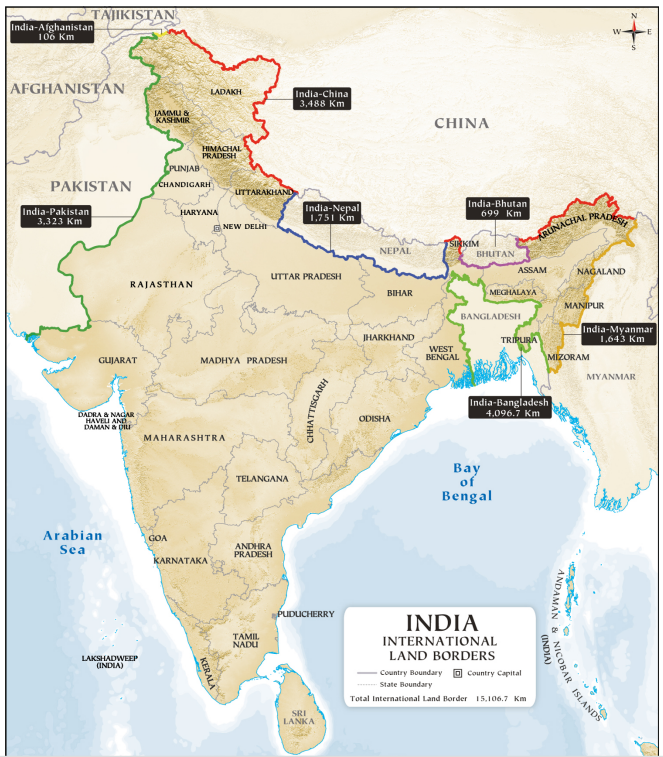International Relations
Free Movement Regime
- 01 Feb 2024
- 7 min read
For Prelims: Free Movement Regime, Issues in Myanmar, Treaty of Yandaboo, India's Act East policy, Manipur, India States Bordering Myanmar, Treaty of Friendship, 1951, Kaladan Multimodal Transit Transport Project.
For Mains: Potential Reasons for Reconsidering the FMR, Major Aspects of India-Myanmar Relations, India’s Border Issues.
Why in News?
India’s recent plans to review the Free Movement Regime (FMR) agreement with Myanmar and fence the India-Myanmar border have initiated discussions, especially in the northeastern states.
- The decision aims to address a complex intersection of historical, cultural, and security considerations.
What is the Free Movement Regime?
- Historical Context:
- Much of India's northeast region was under Burmese occupation until the Treaty of Yandaboo in 1826 established the current India-Myanmar boundary.
- The Treaty of Yandabo was signed by General Sir Archibald Campbell on behalf of the British and Governor of Legaing Maha Min Hla Kyaw Htin on behalf of the Burmese.
- It ended the First Anglo-Burmese War (1824-1826).
- The Treaty of Yandabo was signed by General Sir Archibald Campbell on behalf of the British and Governor of Legaing Maha Min Hla Kyaw Htin on behalf of the Burmese.
- However, the border separated communities with shared ethnicity and culture, including the Nagas in Nagaland and Manipur, as well as the Kuki-Chin-Mizo communities in Manipur and Mizoram, without their agreement.
- Currently, India and Myanmar share a 1,643 km border across Manipur, Mizoram, Nagaland and Arunachal Pradesh, of which only 10 km is fenced, in Manipur.
- Much of India's northeast region was under Burmese occupation until the Treaty of Yandaboo in 1826 established the current India-Myanmar boundary.
- Free Movement Regime:
- The FMR was established in 2018 as part of India's Act East policy, promoting cross-border movement up to 16 km without a visa.
- Individuals residing at the border need a one-year border pass for stays lasting up to two weeks in the neighbouring country.
- It aimed to facilitate local border trade, improve access to education and healthcare for border residents, and strengthen diplomatic ties.
- The FMR was established in 2018 as part of India's Act East policy, promoting cross-border movement up to 16 km without a visa.
- Potential Reasons for Reconsidering the FMR:
- Security Concerns:
- Increased Infiltration: Concerns have arisen about the influx of illegal immigrants, particularly the Chin, Naga communities and Rohingyas from Myanmar, potentially straining resources and impacting local demographics.
- Drug Trafficking and Arms Smuggling: The porous border facilitates the illegal movement of drugs and weapons, posing a threat to internal security to India and fueling crime.
- In 2022, Manipur witnessed 500 cases filed and 625 individuals arrested under the Narcotic Drugs and Psychotropic Substances (NDPS) Act, as per data from the Chief Minister’s Office.
- Insurgency Activities: The FMR has been misused by insurgent groups operating in northeastern India, allowing them to cross the border easily and evade capture.
- E.g. Kuki National Organisation (KNO) and Kangleipak Communist Party-Lamphel (KCP-Lamphel) in Manipur.
- Socio-economic and Regional Issues:
- Impact on cultural identity: Concerns exist about the preservation of indigenous culture and traditions in border areas, potentially threatened by increased migration.
- Environmental Degradation: Deforestation and illegal resource extraction along the border are attributed to unregulated cross-border movement.
- Regional Dynamics: China's growing influence in Myanmar and its potential impact on border security add another layer of complexity to the situation.
- Security Concerns:
What are the Major Aspects of India-Myanmar Relations?
- Historical and Cultural Ties: India and Myanmar share a long history dating back centuries, with cultural and religious connections deeply rooted in Buddhism.
- Treaty of Friendship, 1951 forms the foundation of their diplomatic relations.
- Economic Cooperation: India is Myanmar's 4th largest trading partner and a major source of investment.
- The projects in which India has been involved in Myanmar include the Kaladan Multimodal Transit Transport Project, the Trilateral Highway Project and restoration and conservation of Ananda Temple in Bagan (completed in 2018).
- Disaster Relief: India has responded promptly and effectively in rendering assistance following natural calamities in Myanmar like Cyclone Mora (2017), earthquake in Shan State (2010) and the outbreak of influenza virus in Yangon in July-August 2017.
Way Forward
- Focus on Shared Interests: Continuing and expanding economic cooperation in areas like infrastructure, energy, and trade could benefit both nations, fostering deeper ties beyond political differences.
- Also, encouraging cultural exchanges, religious tourism can build trust and understanding between the people of both countries.
- Comprehensive Border Management: India needs to develop a comprehensive and balanced approach to border management that considers security concerns while facilitating legitimate cross-border activities with Myanmar.
- Supporting a Democratic Transition: India's engagement in Myanmar should ultimately aim to support a peaceful transition to democracy in Myanmar, even if the process is slow and challenging.
- A stable and democratic Myanmar aligns with India's vision for regional stability and prosperity, making this a long-term strategic goal.
UPSC Civil Services Examination Previous Year Question (PYQ)
Prelims
Q. Department of Border Management is a Department of which one of the following Union Ministries? (2008)
(a) Ministry of Defence
(b) Ministry of Home Affairs
(c) Ministry of Shipping, Road Transport and Highways
(d) Ministry of Environment and Forests
Ans: (b)
Mains
Q1: Analyze the multidimensional challenges posed by external state and non-state actors, to the internal security of India. Also discuss measures required to be taken to combat these threats. (2021)
Q2: For effective border area management, discuss the steps required to be taken to deny local support to militants and also suggest ways to manage favourable perception among locals. (2020)
Q3: Border management is a complex task due to difficult terrain and hostile relations with some countries. Elucidate the challenges and strategies for effective border management.(2016)








